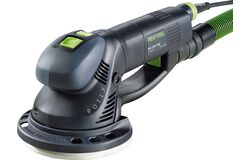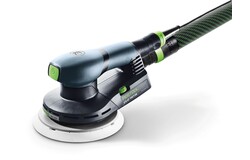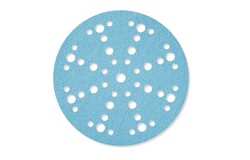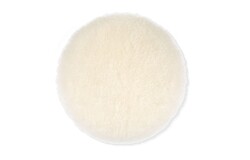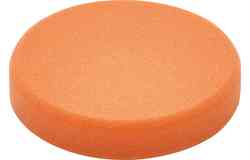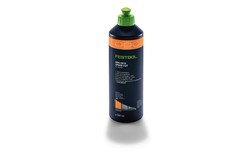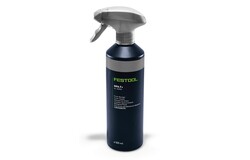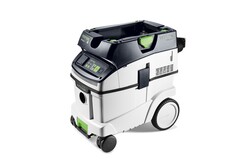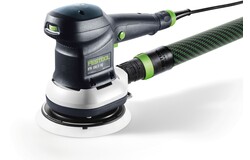Sanding plastic boats and polishing the gelcoat

Description
Black dry guide coat powder makes it is easier to see scratches and damage in the white gelcoat, making them easier to polish.
Tools/accessories
Alternative tools
Preparation/set-up
-
Clean the surface thoroughly before starting to sand and polish the gelcoat. There must be no dirt on the surface, as this could cause new scratches.

-
Scratches that have penetrated the gelcoat cannot be repaired by sanding and polishing alone.

Procedure
-
Preliminary sanding of the anti-fouling coating
Geared eccentric sander ROTEX RO 150 FEQ-Plus
- Lightly sand the anti-fouling coating. Place the Granat P80 – P120 abrasive on the sanding pad.
- Now sand the coating at a speed setting of 4–6, without applying pressure, until you have an even, matt surface. The pad must rotate continuously. Cracks or loose coatings must be removed until there is a stable surface. Cracks and deep scratches must be sanded extensively. Always work with dust extraction and a dust mask.
- Clean the surface with a cloth before coating it.

-
Sanding gelcoat with deep scratches or damage
Eccentric sander ETS 150/3 or geared eccentric sander Rotex Ro 150
- Place the Granat P80 – P120 abrasive on the sanding pad.
- Now sand the coating at a speed setting of (4–6 ETS) or (2–5 RO in the Rotex rotary motion), without applying pressure, until you have an even, matt surface and the scratch or damage is no longer visible. The pad must rotate continuously. Cracks or loose coatings must be removed until there is a stable surface. The damage must be sanded extensively. Always work with dust extraction and a dust mask.
- Clean the surface with a cloth before coating it.
- After repairing the gelcoat, surface sand the area, as described in the next point, to prepare it for polishing.

-
Sanding gelcoat with minor scratches to prepare for polishing.
Eccentric sander ETS 150/3 or geared eccentric sander Rotex Ro 150
- Attach Granat P180- P1200 abrasive to the sanding pad.
- Now sand the coating at a speed setting of (4–6 ETS) or (3–6 RO in the Rotex rotary motion), without apply pressure, until you have an even, matt surface and the scratch or repaired damage is no longer visible. The pad must rotate continuously. Always work with dust extraction and a dust mask.
- Clean the surface with a microfibre cloth.
- Repeat the sanding process with grit of up to P800–P1500, to reduce the roughness.
- Clean the surface with a microfibre cloth.
- When all the unevenness has been removed, the surface can be polished.

-
Polishing
SHINEX RAP 150 premium sheepskin and Speedcut MPA 5010 polish
- Affix the sheepskin or orange polishing sponge to the SHINEX RAP 150 rotary polisher. The sheepskin is slightly more abrasive than the orange-coloured polishing sponge and therefore provides a faster work result.
- Apply MPA 5010 polish to the sheepskin or polishing sponge.
- With the SHINEX RAP 150 rotary polisher (switched off) and the sheepskin or polishing sponge, distribute the polish evenly over the surface.
- Only polish small areas at a time so that the polish does not dry out.
- Start the SHINEX RAP rotary polisher at speed 1 and distribute the polish evenly.
- While the machine is running, set the speed to level 3–4.
- Guide the machine rapidly over the surface, otherwise there is a risk of excessive heating of the surface.
- Wipe the surface with the green microfibre polishing cloth and the finish-cleaner and inspect the surface. It should have a completely even gloss finish. If necessary, the process can be repeated.

-
Our illustrated guides and work results are documented working steps that we have performed in practice. They are individual examples and do not guarantee or promise that users will obtain the same results. The results will depend on the user's experience and skill, as well as the material being used. Illustrated guides do not replace any Festool operating manuals and/or safety instructions. Liability for ensuring that the information, instructions and applications are free from content defects and defects of title, in particular with regard to the absence of defects, correctness, freedom from third party intellectual property rights and copyrights, completeness and fitness for purpose, is excluded. Claims for damages made by the user, regardless of their legal basis, are excluded. These liability exclusions are not applicable if the damage was intentional or caused by gross negligence, or in cases of statutory liability.
We cannot accept liability for damage resulting from defects.↑







































